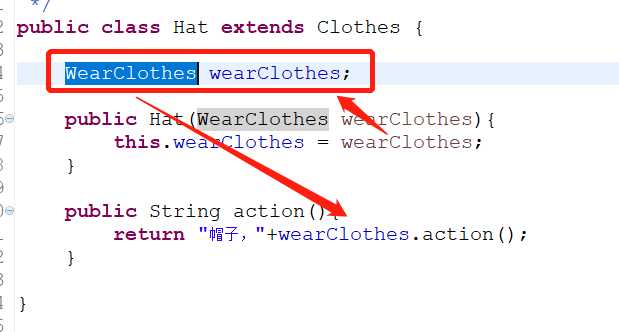装饰者模式
时间:2020-01-09 19:07:35
收藏:0
阅读:97
最近学习设计模式,跟着《大话设计模式》和《Head First设计模式》两本书边练边学,学到装饰者模式的时候,死活理解不了装饰者模式是怎么调用的,最后搜索了很多资料,才搞明白装饰者模式是怎么层层调用的。
下面先贴下代码
1.WearClothes

/** * 穿衣服 * 装饰者模式中的Component,定义一个抽象接口,用于统一具体对象和wear类型一致。 * @author huanglg * */ public abstract class WearClothes { public String action(){ return "穿衣服的操作"; } }
2.Tom

/** * 具体穿衣服的人 * 装饰者模式中的ConcreateComponent,定义一个具体对象。 * @author huanglg * */ public class Tom extends WearClothes { @Override public String action() { return "汤姆刚刚起床,准备穿衣服。"; } }
3.Clothes

/** * 衣服抽象类 * 装饰者模式中的Decorator,装饰抽象类。 * @author huanglg * */ public abstract class Clothes extends WearClothes { public String action(){ return null; }; }
4.Hat

/** * 帽子 * 装饰者模式中的ConcreateDecorator,具体的装饰对象。 * @author huanglg * */ public class Hat extends Clothes { WearClothes wearClothes; public Hat(WearClothes wearClothes){ this.wearClothes = wearClothes; } public String action(){ return "帽子,"+wearClothes.action(); } }
5.Pants

/** * 裤子 * 装饰者模式中的ConcreateDecorator,具体的装饰对象。 * @author huanglg * */ public class Pants extends Clothes { WearClothes wearClothes; public Pants(WearClothes wearClothes){ this.wearClothes = wearClothes; } public String action(){ return "休闲裤,"+wearClothes.action(); } }
6.Shone

/** * 皮鞋 * @author huanglg * */ public class Shone extends Clothes { WearClothes wearClothes; public Shone(WearClothes wearClothes){ this.wearClothes = wearClothes; } public String action(){ return "皮鞋,"+wearClothes.action(); } }
7.Tshirt

/** * T恤 * 装饰者模式中的ConcreateDecorator,具体的装饰对象。 * @author huanglg * */ public class Tshirt extends Clothes { WearClothes wearClothes; public Tshirt(WearClothes wearClothes){ this.wearClothes = wearClothes; } public String action(){ return "T恤,"+wearClothes.action(); } }
8.最后的测试类Test

public class Test { public static void main(String[] args) { WearClothes wearClothes = new Tom(); Hat hat = new Hat(wearClothes); Tshirt tshirt = new Tshirt(hat); Pants pants = new Pants(tshirt); Shone shone = new Shone(pants); String wear = shone.action(); System.out.println(wear); } }
解析:
WearClothes wearClothes = new Tom();
Hat hat = new Hat(wearClothes);
Tshirt tshirt = new Tshirt(hat);
Pants pants = new Pants(tshirt);
Shone shone = new Shone(pants);
String wear = shone.action();
这段代码中Hat包装了Tom对象,然后通过构造器将Tom对象给了Hat对象中的成员变量WearClothes,

然后Tshirt又包装了Hat对象,按照测试类中的从上往下的顺序依次包装,最后在运行的时候,最外层的Shone对象执行action()时,里面的wearClothes.action()执行的是
Pants的action方法。
如果还是不太理解,参考https://www.cnblogs.com/yuhanghzsd/p/5364836.html。
评论(0)

